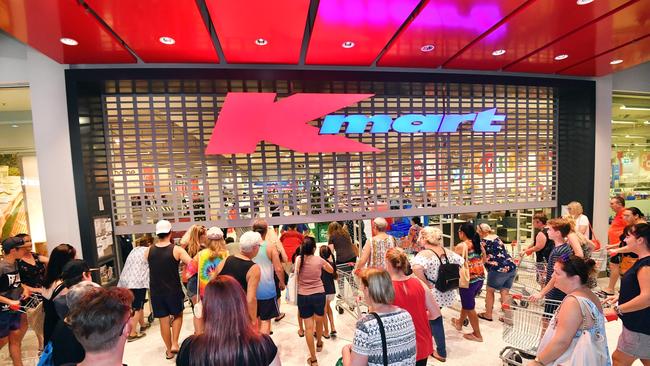Why Grafton doesn’t need a Kmart or another $2 shop
With the new bridge done and the highway about to shunt travellers past, getting the right retail mix is crucial for the future

Opinion
Don't miss out on the headlines from Opinion. Followed categories will be added to My News.
What's the future of retail going to be like in the Clarence Valley?
If you're a regular on The Daily Examiner's Facebook page you will know that whenever mention of a new store is announced there are at least half a dozen comments expressing the desire for a Kmart. Doesn't matter what the other new shop is. They just want a Kmart.
The pining for the cheap and cheerful variety store has a bit of a cult following here in Grafton. Despite having other variety stores with similar lines available within striking distance, the problem appears to be that it's not Kmart.
I'm not sure how to break it to those fans of the store, but I don't think point-blank demand is what these multinationals hinge their decision-making on.
And with a brand new store recently opened in Coffs Harbour, which is now less than an hour down the upgraded highway, it's unlikely our demographic can support such an addition at the level Kmart are accustomed to. Especially in a climate where many of the household names we've grown up with are also receiving a battering in this brave new world of retail.
The more traditional players have had to seriously reinvent themselves over the past few years as consumer demands are rapidly changing. The online shopping juggernaut is here to stay and the impact consumerism has on the environment is becoming more and more transparent.
Businesses that want to set themselves up for the future have had to think smarter but also more ethically.
Which brings me back to the Clarence.
Sure, there are always going to be those who just want trendy stuff cheap, cheap, cheap, but there are others who are looking for companies that sell responsibly sourced, sustainable items that will go the distance. But you can count the latter stores ticking these boxes here on one hand.
Yes these products can be more expensive, but as demand for them rises, prices should come down. And let's face it. There are well-heeled people around these parts too.
Presenting those consumer opportunities and piquing their interest has to start somewhere.
At the moment Grafton has itself earmarked as a chain store town, which in the current climate of consumer demands is seeming more and more like a short-term outlook.
That doesn't mean they shouldn't be here at all because some stores do it really well, but a healthy mix of shopfronts would be a step up in offering a more refreshing retail landscape in Grafton for both locals and visitors to experience.
So let's break that down into manageable morsels.
Enticing people to want something and purchase it is what keeps the retail industry ticking over, whether it's from a bricks and mortar shop or an online giant like Amazon.
But we are also beginning to see how much stuff is going to landfill, how inundated op shops are with unwanted clothes and goods. There's so much stuff out there and that is weighing on the minds of more and more consumers.
That's why there are new businesses springing up with that in mind, and there's scope for the Clarence to get in on the act.
If there was a serious campaign to attract and support small business start-ups thinking about going down that path, then what have we got to lose except a few empty shopfronts.
One of the retail success stories is the quality 'second-hand' store. But that outdated, unappealing term has been replaced with words like vintage, retro or preloved and upcycled. When done well these businesses can thrive against the tide of retail challenges currently being experienced.
These stores are no longer associated with being dirty or cheap. They are set up like a proper store and often feature a mix of things such as vintage, handmade and new ethically sourced items. There are some amazing examples across the country and a few around the Clarence region.
There are stores that sell new homewares and interior design items but they will also have locally produced art and pottery in the mix. There are businesses dedicated to only eco-products, or boutiques that only sell preloved clothing or handmade fashion but are presented the same way a high-end boutique would display new designer gear. The prices are affordable but it's not an op shop, nor does it look like one.
To illustrate the reach this thinking has now, even international fashion designers are repurposing previous season's fashion, pulling apart unsold stock and using it their new lines with equally hefty price tags.
Then there are the service industries like cafes, florists, printers, providores and bespoke businesses fix things the old fashioned way. There are already success stories of these in the Clarence, some even capable of pulling traffic off the highway, but it's a hotchpotch affair.
Retail thrives on retail and getting a cluster of these kinds of businesses together is what draws in the big crowds.
Take Sanctus Brewery at Townsend (near Maclean) for example. It's already had a MONA effect (Tasmania's recent boon off its world-class art museum) on the residential slash industrial area that, up until recently, was a place you drove past on the way to the beach (unless you lived there).
Yet to see it first hand, talk of how packed the place is and how finding a park there has become a bit of a problem abounds. Who'd a thought there'd be a parking problem in Townsend?
So why wouldn't a vintage or handmade shop or local artisan want a piece of that action. Piggy-backing off other's success grows more success. Visitors will travel and explore an area if they hear good things about it.
Some travellers have been known to plan trips around awesome strips of cafes, microbreweries or distilleries and cute little shops. Grafton, the home of brewing, is crying out for a similar set-up surely.
For things like that to happen, aspiring small business operators need support. From landlords, from business chambers, from the local council and from locals.
Setting up a new business ain't cheap nor a stress-free exercise, but with success stories already around, getting a leg up to see if they will come, like they did in Townsend, is crucial in helping operators get past first base.
We're not Brooklyn or Byron Bay but geez, is our future really in selling disposable fashion or plastic crap made in China that eventually ends up in landfill or inside a turtle? Can we just rely on an upgraded regional gallery to be Grafton's MONA?
Change is driven from the top. It doesn't mean putting an abrupt halt to everything already here, but the broader canvassing and encouraging to mix up our retail landscape has to start somewhere. It has to be supported in an official capacity to achieve the consistency and volume required to start changing a place's reputation.
Some towns banned plastic bags well before the supermarkets and governments got on board, so it is possible to get things happening from a local level.
We just need the same passion we have for a Kmart to get there.
Originally published as Why Grafton doesn’t need a Kmart or another $2 shop


